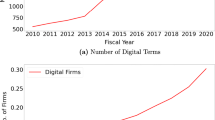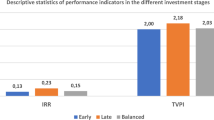Abstract
We develop and empirically test a theoretical model which analyzes the impact of growth options, profitability, and operating and financial leverage on equity’s systematic risk. Conditioning on the relative magnitude of advertising expenditure to research and development (R&D) expenditure, we find that higher beta is associated with higher return volatility, lower book to market ratio, lower return on assets, higher operating and financial leverage, and larger market capitalization (Size). Conditioning on R&D intensity, we show that an increase in the moneyness of firm options, or the exercise of firm options (approximated by increases in capital expenditure, advertising expenditure or profitability) result in more significant decreases in beta. Dynamically estimated high-frequency betas appear to perform well in capturing variation in firm systematic risk associated with growth option factors.


Similar content being viewed by others
Notes
For better tractability, we assume the same horizon for option exercise and the maturity of debt. Furthermore, the independence of value of assets in place with PVGO necessitates an additional assumption which requires that in states where the firm decides to default are not the same with those where it decides to exercise the option to expand. Since PVGO option is exercised when eG A > XG and the equity holders continue operations from existing assets in place when A > (XC +F), this condition can be ensured with an additional assumption that (XC + F) is less or equal to XG/eG.
Available upon request.
These results are verified when we run regressions on R&D and Advertising intensities separately.
References
Andersen TG, Bollerslev T, Diebold F, Wu J (2005) Realized beta: persistence and predictability. Advances in econometrics: econometric analysis of economic and financial time series in Honor of RF Engle and CWJ Granger B
Anderson CW, Garcia‐Feijóo L (2006) Empirical evidence on capital investment, growth options, and security returns. J Financ 61:171–194
Ang A, Hodrick JR, Xing Y, Zhang X (2006) The cross-section of volatility and expected returns. J Financ 61(1):259–299
Berk JB, Green RC, Naik V (1999) Optimal investment, growth options, and security returns. J Financ 54(5):1553–1607
Bernardo A, Chowdhry B, Palia D, Sernova E (2000) Real options and the diversification discount. In: 4th annual international real options conference
Bernardo AE, Chowdhry B, Goval A (2007) Growth options, beta and the cost of capital. Financ Manag 36(2):1–13
Black F, Scholes M (1976) The pricing of options and corporate liabilities. J Polit Econ 81:637–659
Brealey R, Myers S, Allen F (2008) Principles of corporate finance, 9th edn. McGraw-Hill, Boston
Broadie M, Chernov M, Johannes M (2009) Understanding index option returns. Rev Financ Stud 22:4493–4529
Carlson M, Fisher A, Giammarino R (2004) Corporate investment and asset price dynamics: implications for the cross-section of returns. J Financ 59:2577–2603
Chambers D, Jennings R, Thomson RB (2002) Excess returns to R&D intensive firms. Rev Account Stud 7:133–158
Chan LKC, Lakonishok J, Sougiannis T (2001) The stock market valuation of research and development expenditures. J Financ 56(6):2431–2456
Chen L, Zhang L (2010) A better three-factor model that explains more anomalies. J Financ 65(2):563–595
Cochrane J (2005) Asset pricing (Revised Edition). Princeton University Press, Princeton
Constantinides GM (1978) Market risk adjustment in project valuation. J Financ 33(2):603–616
Cooper I (2006) Asset pricing implications of nonconvex adjustment costs and irreversibility of investment. J Financ 61(1):139–170
Coval JD, Shumway T (2001) Expected option returns. J Financ 56:983–1009
Dimson E (1979) Risk measurement when shares are subject to infrequent trading. J Financ Econ 7(2):197–226
Eberhart AC, Maxwell WF, Siddique AR (2004) An examination of the long-term abnormal stock returns and operating performance following R&D increases. J Financ 59:623–650
Elton EJ (1999) Expected return, realized return, and asset pricing tests. J Financ 54(4):1199–1220
Fama FF, French KR (1992) The cross-section of expected return. J Financ 47:427–465
Fama FF, French KR (1993) Common risk factors in the returns on stocks and bonds. J Financ Econ 33:3–56
Fama FF, French KR (1995) Size and book-to-market factors in earnings and returns. J Financ 50:131–155
Goetzmann W, Ingersoll J, Spiegel M, Welch I (2007) Portfolio performance manipulation and manipulation-proof performance measures. Rev Financ Stud 20:1503–1546
Gomes J, Kogan L, Zhang L (2003) Equilibrium cross-section of returns. J Polit Econ 111:693–732
Graham JR, Harvey CR (2001) The theory and practice of corporate finance: evidence from the field. J Financ Econ 60:187–243
Griffin JM, Lemmon ML (2002) Book-to-market equity, distress risk and stock returns. J Financ 57:2317–2336
Hackbarth D, Morellec E (2008) Stock returns in mergers and acquisitions. J Financ 63(3):1213–1252
Hansen LP, Richard S (1987) The role of conditioning information in deducing testable restrictions implied by dynamic asset pricing models. Econometrica 55:587–614
Jagannathan R, Meier I (2002) Do we need CAPM for capital budgeting? Financ Manag 31:55–77
Kothari SP, Laguerre TE, Leone AJ (2002) Capitalization versus expensing: evidence on the uncertainty of future earnings from capital expenditures versus R&D outlays. Rev Account Stud 7:355–382
Koussis N, Martzoukos S, Trigeorgis L (2007) Real R&D options with time-to-build and learning-by-doing. Ann Oper Res 51:29–55
Koussis N, Martzoukos S, Trigeorgis L (2012) Multi-stage product development with exploration, value-enhancing, preemptive and innovation options. J Banking Financ 37(1):174–190
Kumar P, Sorescu SM, Boehme RD, Danielsen BR (2008) Estimation risk, information, and the conditional CAPM: theory and evidence. Rev Financ Stud 21:1037–1075
Lambertides N, Trigeorgis L (forthcoming) The role of growth options in explaining stock returns. J Financ Quant Anal
Lee C-F, Chiou W-JP, Lee AC (2009) Variation in stock return risks: an international comparison. Rev Pac Basin Financ Market Policies 12(2):245–266
Leland HE (1999) Beyond mean-variance: performance measurement in a nonsymmetrical World. Financ Anal J 55:27–36
Lev B, Sougiannis T (1996) The capitalization, amortization and value relevance of R&D. J Account Econ 21:107–138
Lev B, Sougiannis T (1999) Penetrating the book-to-market black box: the R&D effect. J Bus Financ Account 26:419–449
Lewellen J, Nagel S (2006) The conditional CAPM does not explain asset pricing anomalies. J Financ Econ 82:289–314
Lintner J (1965) The valuation of risk assets and the selection of risky investments in stock portfolios and capital budgets. Rev Econ Stat 47(1):13–37
Louis K, Chan C, Lakonishok J, Sougiannis T (2001) The stock market valuation of research and development expenditures. J Financ 56:2431–2456
Mensah YM (1992) Adjusted accounting beta, operating leverage and financial leverage as determinants of market beta: a synthesis and empirical evaluation. Rev Quant Finance Account 2(2):187–203
Merton RC (1974) On the pricing of corporate debt: the risk structure of interest rates. J Financ 29(2):449–470
Mizik N, Jacobson R (2003) Trading off between value creation and value appropriation: the financial implications of shifts in strategic emphasis. J Mark 67:63–76
Morelli D (2012) Security returns, beta, size, and book-to-market equity: evidence from the Shanghai A-share market. Rev Quant Finance Account 38(1):47–60
Novy-Marx R (2011) Operating leverage. Rev Financ 15(1):103–134
Schlueter T, Sievers S (2013) Determinants of market beta: the impacts of firm-specific accounting figures and market conditions. Rev Quant Financ Account. doi:10.1007/s11156-013-0352-1
Sharpe W (1964) Capital asset prices: a theory of market equilibrium under conditions of risk. J Financ 19(3):425–442
Skinner DJ (2008) Accounting for intangibles–a critical review of policy recommendations. Account Bus Res 38(3):191–204
Trigeorgis L (1996) Real options: managerial flexibility and strategy in resource allocation. MIT Press, Cambridge
Vassalou M, Xing Y (2004) Default risk in equity returns. J Financ 59:831–868
Wan-Jiun PC, Lee AC, Lee C-F (2009) Does idiosyncratic volatility matter? New Zealand evidence. Rev Pac Basin Financ Market Policies 12
Zhang L (2005) The value premium. J Financ 60:67–103
Acknowledgments
We are grateful to participants at the 2012 Multinational Finance Society conference for useful comments and to George Skiadopoulos for useful suggestions and discussion.
Conflict of interest
The authors declare that they have no conflict of interest.
Author information
Authors and Affiliations
Corresponding author
Rights and permissions
About this article
Cite this article
Koussis, N., Makrominas, M. Growth options, option exercise and firms’ systematic risk. Rev Quant Finan Acc 44, 243–267 (2015). https://doi.org/10.1007/s11156-013-0405-5
Published:
Issue Date:
DOI: https://doi.org/10.1007/s11156-013-0405-5




